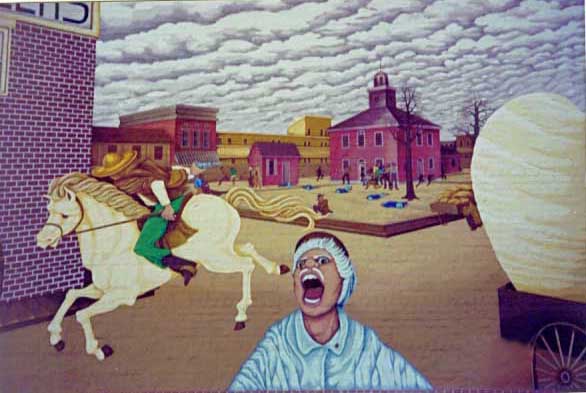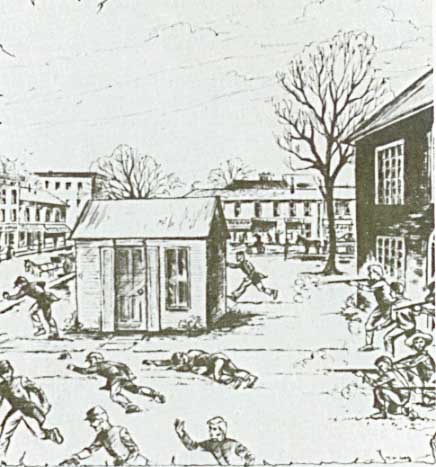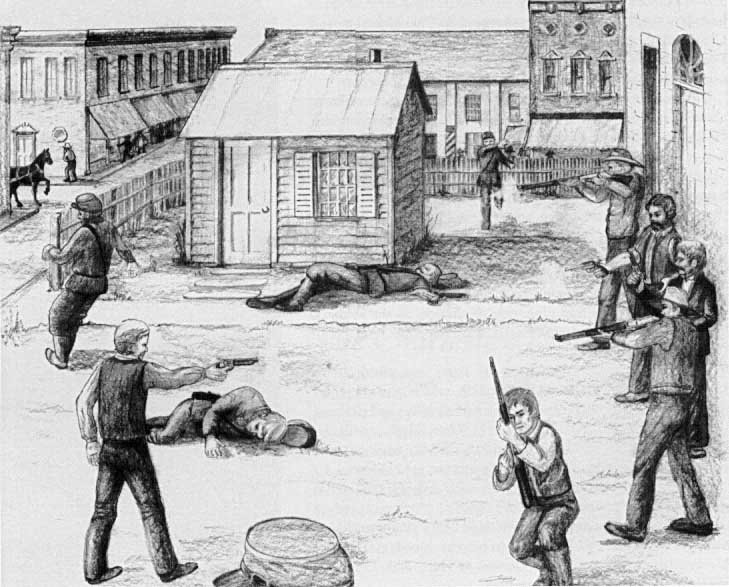The Charleston Riot

Painted by Rebecca Sawyer Spoon of Charleston, this mural portrays the Charleston Riot of March 28, 1864. It is the largest of the murals, measuring 40 feet wide by 20 feet tall, and many of the details can only be appreciated with binoculars. Violence resulted when Union soldiers and local Republicans encountered Peace Democrats on the square. The Peace Democrats, or "Copperheads," represented those who were anti-Lincoln Administration, anti-draft, pro-slavery, and those who favored an armistice to end the Civil War. The Copperheads identified themselves by wearing an Indian Head Pin (on the collar of the man in the foreground), which symbolized their resistance to the draft. By the time the shooting ended, the riot left nine dead and twelve wounded. (It is important to note that the courthouse in this mural is missing its 1858 addition, and that the soldiers were actually not in uniform during the riot).
Many people are unaware of how divided the nation was during the Civil War. Not only was there a northern/southern division (which resulted in the Civil War), but people were also divided on the northern homefront - as evidenced by this mural. Although a large Republican majority existed in the north, the Democratic party represented a strong minority. Among those in the Democratic party were conservative Peace Democrats, a.k.a. Copperheads. The largest groups of Copperheads resided in the Midwest, and especially in the east-central Illinois region. Many local residents joined the ranks of the Copperheads during the Civil War. Even though Abraham Lincoln, a Republican, practiced law here, and had many friends and relatives in the region, Coles County had strong Copperhead support. Republicans during that time, and many  historians later, have deemed them "traitors" because of their resistance to Lincoln's policies. The term "Copperhead" was actually coined by Republicans during the early stage of the war, comparing Peace Democrats to the deadly copperhead snake. This political cartoon from the war illustrates Republican opinions of Copperheads. Here, Lady Liberty fights off Copperhead leaders.
historians later, have deemed them "traitors" because of their resistance to Lincoln's policies. The term "Copperhead" was actually coined by Republicans during the early stage of the war, comparing Peace Democrats to the deadly copperhead snake. This political cartoon from the war illustrates Republican opinions of Copperheads. Here, Lady Liberty fights off Copperhead leaders.
The Charleston Riot represents one of many conflicts that escalated to violence between Republicans and Copperheads during the Civil War. The riot was the result of years of political tensions, personal animosities, partisanship, and many other conflicting forces. On March 28, 1864, local Democrats held a rally on the square, where many influential Democratic leaders were to speak. Late in the morning, soldiers on leave from the 54th Illinois Infantry stopped in Charleston on their way to Mattoon. They stacked their rifles at the train depot and proceeded into town, where many local Peace Democrats had already gathered. After a great deal corn whiskey was consumed by local Copperheads, Republicans, and the soldiers, violence finally broke out around three in the afternoon. Historians are not sure who fired the first shot, but many of the Copperheads immediately ran to their wagons hitched around the square and pulled out revolvers and rifles from underneath the straw. The soldiers were at a disadvantage because their rifles were still at the depot north of the square. Coleman and Spence describe, "a picturesque figure during the shooting was John Frazier, a farmer, who had started for home but returned when he heard the shooting. He rode around the square on his horse, shooting at the soldiers and shouting encouragement to the Democrats." He is portrayed in the mural. The shooting only took place over a couple of minutes, but in that time, 9 were killed and 12 wounded - the soldiers received the majority of the casualties. The Copperheads quickly fled town. Rumors of continued violence brought over 2,000 troops from Illinois and Indiana regiments to the region during the next couple of days. Many of the local Copperheads were rounded up, but were eventually pardoned by President Lincoln. Scenes of the riot are depicted in the drawings below.


This mural reveals a number of questions one can pose in future research: In a region composed of many friends and relatives of Lincoln, why was the Copperhead following so strong? Why did many local farmers join the ranks of the Copperheads? What did they fight against? Were there other acts of violence similar to this in the North during the Civil War? How can the study of the riot and Copperhead movement during the war contribute to one's understanding of Charleston's history?









